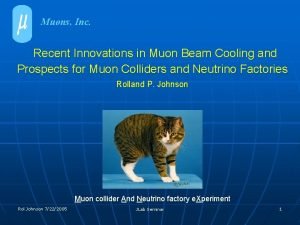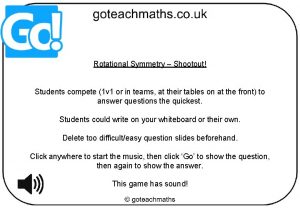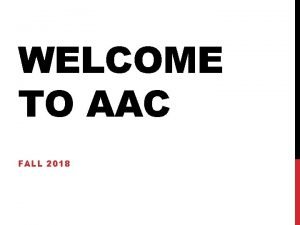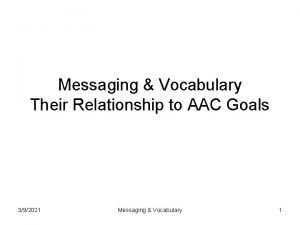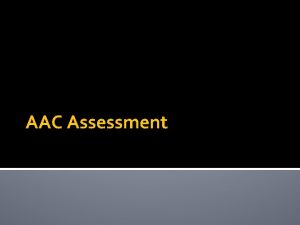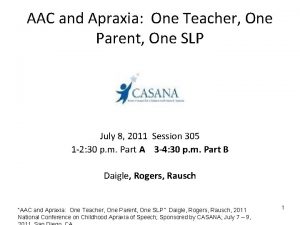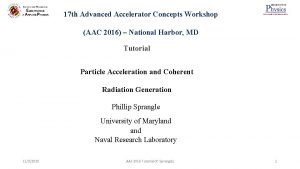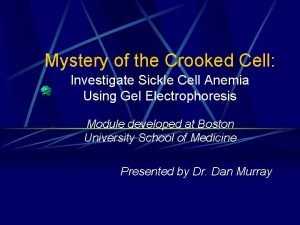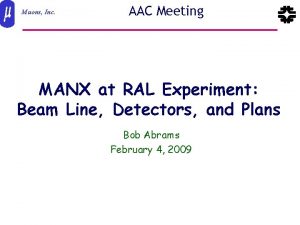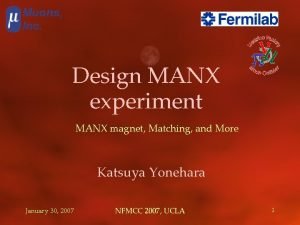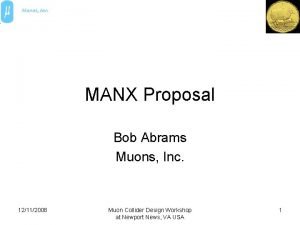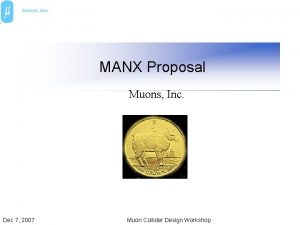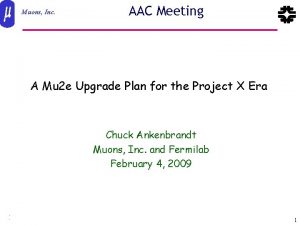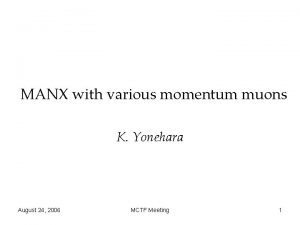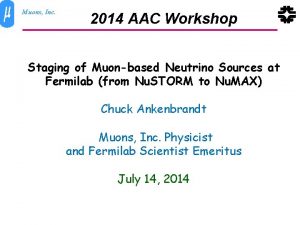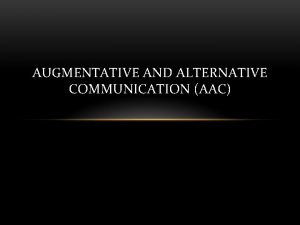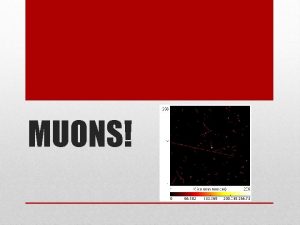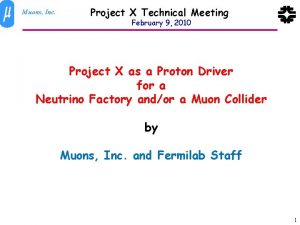AAC Meeting Muons Inc Design of the MANX

















- Slides: 17

AAC Meeting Muons, Inc. Design of the MANX experiment Katsuya Yonehara Fermilab APC February 4, 2009 Feb. 4 2009 Yonehara-AAC 1

Muons, Inc. Contents · Project goal · Simulation results · Summary Feb. 4 2009 Yonehara-AAC 2

Muons, Inc. Goal of this project · Design, engineer, and build a useful device for muon cooling channel studies · Test six-dimensional helical cooling model · Investigate capability and limitation of helical cooling channel Feb. 4 2009 Yonehara-AAC 3

Muons, Inc. Concept of Helical Cooling Channel (HCC) Incident Muon Beam Evacuated Dipole magnet Combined function magnet (invisible in this picture) = Pure solenoid + Helical dipole + Helical quadrupole Red: reference orbit Blue: beam envelop Wedge absorber Incident Muon Beam H 2 gas absorber in Dipole magnet • Dispersive component makes longer (shorter) Emittance exchange Feb. 4 2009 path length for higher (lower) momentum particles → Continuous emittance exchange • Homogeneous field (no periodic structure) makes minimal resonant losses • This fact makes large phase space acceptance Yonehara-AAC 4

Muons, Inc. Simulation study of HCC for Muon Collider 400 MHz HCC λ=1 m, κ=1 200 MHz HCC λ=2 m, κ=1 800 MHz HCC λ=0. 5 m, κ=1 Goal for low emittance MC design Reverse Emittance Exchange (REMEX) Study II Frontend Pre-cooler 200 MHz HCC 400 MHz HCC 800 MHz HCC Parametric Ionization Channel (PIC) p=250 Me. V/c 1600 MHz HCC 6 D Phase space evolution in current HCC Phase space evolution for Muon Collider (solid line: complete simulation, dashed line: in progress) Feb. 4 2009 Yonehara-AAC 5

Muons, Inc. Pre-cooler was the MANX inspiration MANX: HCC w/o RF structure in magnet (Discuss MANX channel later) Feb. 4 2009 Yonehara-AAC 6

Muons, Inc. HCC field parameters Larmor motion in pure solenoid Larmor center HCC magnet center Radial equation of motion with helical dipole HCC wave number a HCC pitch Equation of motion for reference particle Projected motion in transverse (x-y) plane Need to introduce proper helical quad (bϕ)’ to stabilize beam phase space Feb. 4 2009 Yonehara-AAC 7

Muons, Inc. Design of the HCC magnet • Consider continuous RF structure inside HCC • HCC field is generated by helical solenoid (HS) • Field parameters in HS has a geometric restriction • From past HS design study: HS coil radius ~ Helix radius ( a) • It makes a lower limit of pill-box type RF frequency br 2 Coil-1 Example: λ = 1 m, κ = 1. 0, a = 0. 16 m → pillbox RF frequency ~ 800 MHz • High freq RF structure destroys the longitudinal phase space stability • Hence, no cooling in high freq RF channel • Furthermore, additional space between coil and RF cell is needed for thermal isolation, pressure barrier, etc • Required minimum gap = 80 mm Coil-2 Bφ Coil-3 br 1 • Need to adjust (Bz, b, b’) on red dot ( Coil-2 center) • Blue dot and green dot are centers of upstream ( Coil-1) and downstream (Coil-3) HS coils • Coil-1 and Coil-3 generate br 1 and br 2 on red dot • Br on red dot is zero by sum of br 1 and br 2 but those generate Bφ • Bz and Bφ are tuned by the location of HS coil • b’ is tuned by bore of the HS coil → Optimum HS coil radius for cooling ~ Helix radius ( a) HCC magnet center Feb. 4 2009 Reference orbit Yonehara-AAC 8

Muons, Inc. Current progress of RF design Wedge shape RF cell • Done with Lars Thorndahl. Wedge shape RF is considered • Acceleration field direction follows the helix beam path • Induce traveling wave RF structure, hence there is no window between RF cells • Asymmetric field structure in radial direction (y-axis in plot) • Requires large RF power Feb. 4 2009 HS coil Yonehara-AAC 9

Muons, Inc. Compact dielectric RF for HCC 361 MHz Cavity Cu/Steel ceramics (dielectric material) (28. 6 cm radius for 400 MHz pillbox cavity) ceramics Vacuum/H/He 16 cm • Lower frequency RF structure makes larger RF bucket • Reduce transverse size of RF cell by using dielectric material • Gap between RF cell and HS coil is used for power line, thermal isolation, high pressure wall, etc. (w. Popovic, Moretti, Neubauer) Feb. 4 2009 Yonehara-AAC 10

Muons, Inc. Feb. 4 2009 Design MANX Yonehara-AAC 11

Muons, Inc. 6 D Cooling factor: 2 Transverse & Longitudinal Cooling factors: ~1. 3 Feb. 4 2009 Yonehara-AAC 12

Mount MANX at RAL beamline Muons, Inc. Matching section MANX cooling section MICE Spectrometer Matching section Feb. 4 2009 MANX cooling section Yonehara-AAC Matching section 13

Muons, Inc. Key parameters to test HCC theory Measure six variables • Emittance Exchange is the key parameter in this theory • There is a correlation between scattering angle and energy straggling • Simulation does not involve this correlation • We need to know how much this correlation affects the emittance exchange • s and t are the most sensitive parameters for emittance exchange • We need a very fast To. F counter and tracker system in cooling section to measure s and t precisely • Measurement will be done without cooling material 14

Muons, Inc. To. F in HCC and pure solenoid • In a pure solenoid channel, To. F of slow (fast) particle takes more (less) time to reach the other end of the channel • This picture is opposite in HCC (opposite phase slip factor) • Phase slip factor can be tuned by adjusting the dispersion → Even isochronous condition can be realized in HCC • To. F wrt momentum is directly correlated with path length no RF, no absorber No angular dist Blue: Δp = -10 % Pure solenoid Red: Δp = +10 % No absorber No angular dist around reference orbit Red: Δp = +10 % Feb. 4 2009 Yonehara-AAC HCC (kappa =1) Blue: Δp = -10 % 15

Muons, Inc. Future Prospect · RF test in MANX channel It is possible to mount a dielectric RF cell (see slide 10) in the MANX channel Cu/Steel Detectors Cryostat Vessel Cavity + Coil ceramics Vacuum/H/He Feedthroughs Power in Signals out 16

Muons, Inc. Summary · Design MANX experiment · Show simulations · Discuss how to verify HCC model Feb. 4 2009 Yonehara-AAC 17
 Icoolblue
Icoolblue What is the order of rotational symmetry of a manx cross
What is the order of rotational symmetry of a manx cross No tech aac examples
No tech aac examples 18 aac 75
18 aac 75 Coverage vocabulary aac
Coverage vocabulary aac Heaac
Heaac Aac goals
Aac goals Just in time programming aac
Just in time programming aac Aac implementation plan
Aac implementation plan Aac feature matching
Aac feature matching Aac and apraxia
Aac and apraxia Aac
Aac Aac aids
Aac aids Tertiary aac assessment centre
Tertiary aac assessment centre Crooked house aac
Crooked house aac Aac implementation plan
Aac implementation plan Winamp aac encoder
Winamp aac encoder It acquisition advisory council
It acquisition advisory council
